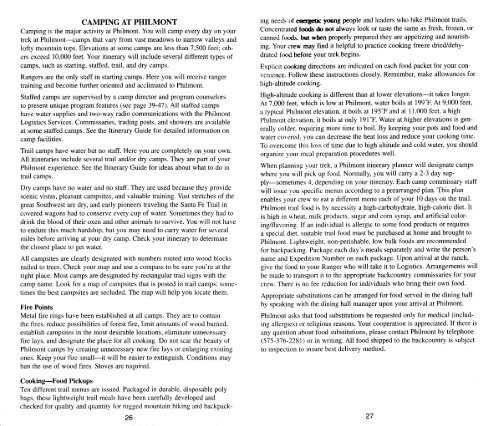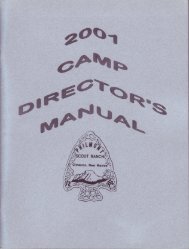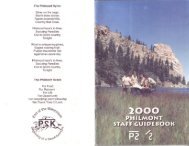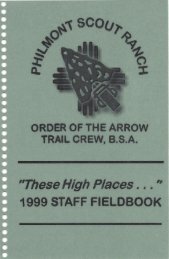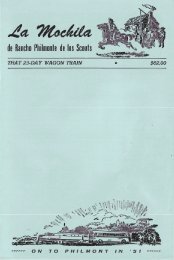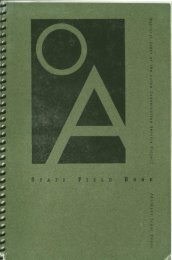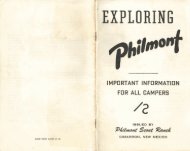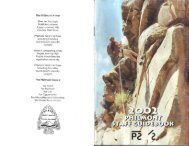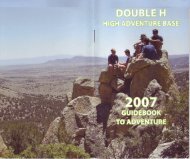Guidebook 2008.pdf
Guidebook 2008.pdf
Guidebook 2008.pdf
You also want an ePaper? Increase the reach of your titles
YUMPU automatically turns print PDFs into web optimized ePapers that Google loves.
CAMPING AT PHILMONT<br />
Camping is the major activity at Philmont. You will camp every day on your<br />
trek at Philmont-s-camps that vary from vast meadows to narrow valleys and<br />
lofty mountain tops. Elevations at some camps are less than 7,500 feet; others<br />
exceed 10,000 feet. Your itinerary will include several different types of<br />
camps, such as starting, staffed, trail, and dry camps.<br />
Rangers are the only staff in starting camps. Here you will receive ranger<br />
training and become further oriented and acclimated to Philmont.<br />
Staffed camps are supervised by a camp director and program counselors<br />
to present unique program features (see page 39-47). All staffed camps<br />
have water supplies and two-way radio communications with the Philmont<br />
Logistics Services. Commissaries, trading posts, and showers are available<br />
at some staffed camps. See the Itinerary Guide for detailed information on<br />
camp facilities.<br />
Trail camps have water but no staff. Here you are completely on your own.<br />
All itineraries include several trail and/or dry camps. They are part of your<br />
Philmont experience. See the Itinerary Guide for ideas about what to do in<br />
trail camps.<br />
Dry camps have no water and no staff. They are used because they provide<br />
scenic vistas, pleasant campsites, and valuable training. Vast stretches of the<br />
great Southwest are dry, and early pioneers traveling the Santa Fe Trail in<br />
covered wagons had to conserve every cup of water. Sometimes they had to<br />
drink the blood of their oxen and other animals to survive. You will not have<br />
to endure this much hardship, but you may need to carry water for several<br />
miles before arriving at your dry camp. Check your itinerary to determine<br />
the closest place to get water.<br />
All campsites are clearly designated with numbers routed into wood blocks<br />
nailed to trees. Check your map and use a compass to be sure you're at the<br />
right place. Most camps are designated by rectangular trail signs with the<br />
camp name. Look for a map of campsites that is posted in trail camps; sometimes<br />
the best campsites are secluded. The map will help you locate them.<br />
Fire Points<br />
Metal tire rings have been established at all camps. They are to contain<br />
the fires, reduce possibilities of forest fire, limit amounts of wood burned,<br />
establish campsites in the most desirable locations, eliminate unnecessary<br />
fire lays, and designate the place for all cooking. Do not scar the beauty of<br />
Philmont camps by creating unnecessary new fire lays or enlarging existing<br />
ones. Keep your fire small-it will be easier to extinguish. Conditions may<br />
ban the use of wood fires. Stoves are required.<br />
Cooking-Food Picknps<br />
Ten different trail menus are issued. Packaged in durable, disposable poly<br />
bags, these lightweight trail meals have been carefully developed and<br />
checked for quality and quantity for rugged mountain hiking and backpack-<br />
26<br />
ing needs of energeticyoung people and leaders who hike Philmont trails.<br />
Concentrated foods do not always look or taste the same as fresh, frozen, or<br />
canned foods. butwhen properly prepared they are appetizing and nourishing.<br />
Your crew may find it helpful to practice cooking freeze dried/dehydrated<br />
food before your trek begins.<br />
Explicit cooking directions are indicated on each food packet for your convenience.<br />
Follow these instructions closely. Remember, make allowances for<br />
high-altitude cooking.<br />
High-altitude cooking is different than at lower elevations-it takes longer.<br />
At 7,000 feet, which is low at Philmont, water boils at 199°F.At 9,000 feet,<br />
a typical Philmont elevation, it boils at 19SOF and at 11,000 feet, a high<br />
Philmont elevation, it boils at only 191°F.Water at higher elevations is generally<br />
colder, requiring more time to boil. By keeping your pots and food and<br />
water covered. you can decrease the heat loss and reduce your cooking time.<br />
To overcome this loss of time due to high altitude and cold water, you should<br />
organize your meal preparation procedures well.<br />
When planning your trek, a Philmont itinerary planner will designate camps<br />
where you will pick up food. Normally, you will carry a 2-3 day supply-sometimes<br />
4. depending on your itinerary. Each camp commissary staff<br />
will issue you specific menus according to a prearranged plan. This plan<br />
enables your crew to eat a different menu each of your 10 days on the trail.<br />
Philmont trail food is by necessity a high-carbohydrate, high-caloric diet. It<br />
is high in wheat. milk products. sugar and corn syrup, and artificial coloringlflavoring.<br />
If an individual is allergic to some food products or requires<br />
a special diet. suitable trail food must be purchased at home and brought to<br />
Philmont. Lightweight. non-perishable, low bulk foods are recommended<br />
for backpacking. Package each day's meals separately and write the person's<br />
name and Expedition Number on each package. Upon arrival at the ranch,<br />
give the food to your Ranger who will take it to Logistics. Arrangements will<br />
be made to transport it to the appropriate backcountry commissaries for your<br />
crew. There is no fee reduction for individuals who bring their own food.<br />
Appropriate substitutions can be arranged for food served in the dining hall<br />
by speaking with the dining hall manager upon your arrival at Philmont.<br />
Philmont asks that food substitutions be requested only for medical (including<br />
allergies) or religious reasons. Your cooperation is appreciated. If there is<br />
any question about food substitutions, please contact Philmont by telephone<br />
(575-376-2281) or in writing. All food shipped to the backcountry is subject<br />
to inspection to insure best delivery method.<br />
27


